In 1993, parishioner Elissa Scalise Powell researched and wrote “A Brief History of Christ Episcopal Church, North Side 1831-1952 & Christ Episcopal Church, North Hills 1952-1963.”
“This history is written September 1993 in celebration of the ‘mortgage burning’ of the 30-year building loan for Christ Episcopal Church, 5910 Babcock Blvd. Throughout this time we remember the spirit that started this project and those who have carried it through these past 30 years. It would be an impossible task to name everyone who contributed to the Christ Church of today but in the following stories, a few do stand out. Though most of us who attend Christ Church today do not remember the old church on the North Side, it was there that what we celebrate now was conceived.”
1831-1952
We must begin our history far back in the past for it is there we have our beginnings. On July 21, 1831, a group of people met at the home of George P. Williams in Allegheny City to organize themselves into a parish. It was the second Episcopal church in what is now the City of Pittsburgh (after Trinity Cathedral). The property, located on the west side of Union Avenue, Allegheny City (now the North Side of Pittsburgh) was purchased from Hugh McGonnegle for $1500. The first frame building, built by James Sterrett, measured 25 x 45 ft. and was opened on December 25, 1831. The first vestry was composed of Alexander Johnston Jr., and William Staunton, wardens, and James Correy, H.F. Schweppe, Charles Brewer, Charles Plumb, Isaac Lightner and John C. Mowrey. The other communicants were James Wilson, George P. Williams, Mrs. Clair, Mrs. Lightner, Mrs. Kedwin, Mrs. Conn, Mrs Brunot and Mrs. Curry. The Rev. G. Upfold presided at the first service and The Rev. Samson K. Brunot delivered the sermon.
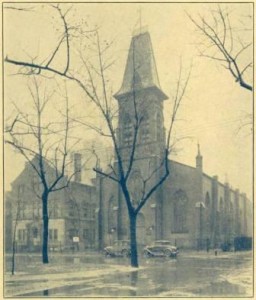 In 1840 a Tudor-style brick building was constructed and the original building was torn down. The new church contained an organ that was built in 1814 in New York and was transported from Philadelphia by the old canal and portaged over the Allegheny Mountains. In 1867, with the addition of the chancel, Christ Church was completed. At this time, prominent members of Christ Church included the Oliver family of Oliver Iron & Steel, the Laughlin family of Jones & Laughlin Steel and the Brunot family of Brunots Island.
In 1840 a Tudor-style brick building was constructed and the original building was torn down. The new church contained an organ that was built in 1814 in New York and was transported from Philadelphia by the old canal and portaged over the Allegheny Mountains. In 1867, with the addition of the chancel, Christ Church was completed. At this time, prominent members of Christ Church included the Oliver family of Oliver Iron & Steel, the Laughlin family of Jones & Laughlin Steel and the Brunot family of Brunots Island.
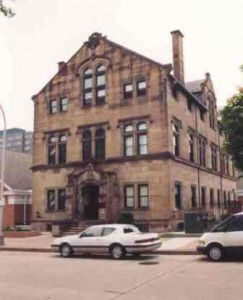
A parish house was added in 1906 at a cost of $55,000 for the purpose of giving to its members and to the community a place for wholesome recreation and meetings. It contained a community room, large dining hall, bowling alleys, gymnasium and billiard room. The dream for a beautiful house of worship and community center had been realized. The brick and stone church building measured 56 x 112 feet and the adjacent 3-story stone Parish House/Rectory was 43 x 85 feet. (Today only this building still stands. You can see it to the left of the church building in the photo above.)
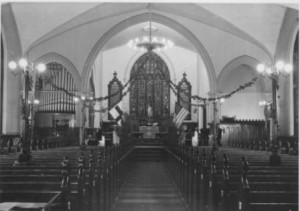
Christ Church was rich in tradition and service which had been made, for the most part, in one location, on one site and for much of the time in one edifice. Consequently the decision to leave that location for the present one was wise but the transition was by no means easy. Many parishioners had carried their little ones to the Baptismal Font in that old church. They had watched them grow and as they were nurtured in the atmosphere of worship they engaged in the many activities of the parish. They had assisted in preparing them for presentation to the Bishop for Confirmation and a great many of them had been married there. To many it had been their lot to see some of their loved ones receive the final benediction of this life at her Altar.
In 1951, due to many of its members having moved to the suburbs, the congregation decided to sell the old building (receiving $96,000 from Christian and Missionary Alliance Church) and select a site for the proposed new Christ Church.
At this time it was observed that Pittsburgh was rapidly extending its boundaries to the North. Many new developments were growing up in the North Hills district. So it became the unanimous decision that a site be secured in the area. All were impressed by the location of the old Jones Estate in Ross Township, then owned and occupied by the Boyds, who agreed to sell. They were able to buy the property on January 22, 1952 for $47,000. The easterly border of Brown’s Lane had been a 16-foot private road, but was widened to 50 feet by 1952. Chapel Drive and Chapel Hill townhouses were just being proposed.
The original parishioners made the choice of leaving the old place with no little reluctance. It required spiritual and moral stamina to make that decision and it indeed was a mighty pull at their heart strings. By the grace of God they had the wisdom and strength to overcome their attachments to the old place for the greater good of Christ Church and for the advancement of Christ’s Kingdom. In coming to this new area they did not promote a pioneering project nor a missionary hope, valuable as those things are. Rather they brought here an organization financially solvent and spiritually robust. The need for the church here was self evident. A door-to-door survey of the entire North Hills by Episcopal Seminarians showed that there was great interest in an Episcopal church in the North Hills because Trinity Cathedral and All Saints’ in Brighton Heights were a distance to travel.
1952-1959 - The Move to the North Hills
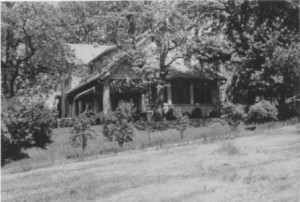
The house on the 5+ acres of the old Jones Estate was considered large enough to hold services on the first floor and also to provide an apartment for the Rector (The Rev. Dr. William J. Bradbury) and his family on the second floor until the construction of the new church was completed. The house had a central staircase, at the bottom of which was placed the altar. The people gathered in the two rooms on either side of the stairwell and could not see those in the other room.
The barn on the east end of the property (now the Education building parking lot) provided, with some renovating, adequate housing for the Church School. Each stall in the barn held a different Sunday School class.The first service was held in the house on the 23rd of March 1952 (Easter Day) with an attendance of 74 adults, including Helen Radford, George & Gretta Johnson, Mary Margaret Anke and her three sons, and Betty Dobson Hunt. Edith Richards, the Heckels, the Arbuckles, the Armstrongs and the Woods were some of the 12 original families from the North Side Church. At the next Sunday service the choir made its debut, having had a previous commitment the week before to sing at The Church of the Epiphany in Avalon for Easter.
Christ Church made itself visible in the community immediately by offering one of the first Nursery schools in the North Hills, located in the original house. For many years it offered a weekday Kindergarten which is now a pre-school with programs for children from 2 1/2 years to 5-years old.

Sunday by Sunday the congregation had continued to grow to such an extent that by the end of the year there were 225 families on the roll and it was felt necessary to start planning for the construction of the new church. A committee was formed under the leadership of Mr. James E. Dobson. So efficiently did this committee operate that ground was broken for the first unit of the new building on May 17, 1953.
Participants in the ceremony were Mr. A.H. Heckel and Mrs. Jane Nye, representing the old Christ Church, and Mr. Edward Tait and Mrs. Albert Anke, representing the new Christ Church. Mr. Elmer J. Uhl was selected as the Contractor and construction started immediately. The construction schedule was held up slightly while the sewer line was eventually tied into the same one as the Swan Acres plan of homes.
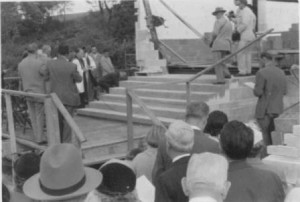
The cornerstone was laid on September 13, 1953.
The first service was held in the English Gothic styled building on Christmas Eve, December 24, 1953. This, by coincidence, happened to be the 121st Anniversary of the founding of Christ Church and consequently made the first service one of great significance to all.
After the first building was completed in 1953 , the mortgage of $65,000 was paid off in five years time! This had been done through the sacrificial giving on the part of all members.
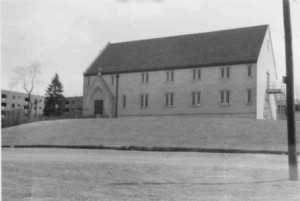
On the second floor of the new church was the worship area. Originally, the hillside in the back of the church (where the playground is now) was to be cut back and replaced with a parking lot. The main entrance to the church would have been off that parking lot. The third floor included an activity area and basketball court. The church secretary’s office was also on the third floor. The undercroft held a kitchen and open area. This undercroft was the site of many spaghetti dinners held to raise funds for the next church building. (It has been said that the present church’s mortar is actually spaghetti sauce!)
1959-1963 - Growing and adding on

In 1959, a Building and Planning Committee was organized under the chairmanship of Mr. Ralph Frederick to begin the formulation of plans for our present church building.
Their first task was to interview architects. This they did for several months and on December 14, 1959 selected Mr. Thomas C. Pratt. Mr. Pratt started work on the preliminary plans which were presented to the congregation in January, 1961 and accepted. It was the original intent to build the church complex in the form of a cross . To conform to this intent, with the placement of the first building as it was constructed, would have forced the church proper, as a cross arm, to have an extremely high elevation at the entrance. Hence, the only solution was to build the complex in the form of a flattened “Z” and reject the cross concept. The first building has been built of stone; for conformity and beauty, it was necessary to build the new building of stone. However, the cost of stone had increased and the building committee was forced to substitute brick for stone on the back of the church.
In conjunction with this step our Finance Committee was reorganized under the general chairmanship of Mr. J. Hampton Johnston to consider ways and means of financing the new building. After much discussion and thorough deliberation, it was considered necessary to seek some expert help for the successful conducting of the campaign. Mr. Edward Sullivan, Publicity Director for the Council of Churches and a man with a vast experience in fundraising was invited to assist us in our canvass. He consented to do so and, under his expert guidance, we conducted a satisfactory canvass and realized, in pledges, the sum of $275,404 to be paid over a period of three years.
The success of the canvass was due not alone to expert planning but to the devoted leadership of Mr. Russell C. Gourley, General Chairman and Mr. Robert E. C. Henry, Canvass Chairman and all the men of the congregation who assisted them, as well as to the interest, enthusiasm and devoted concern and sacrifice on the part of every member of our congregation. There was a period of two or three years when each family was given $10 and was expected to give it back with its “earnings.” For instance, one of the years, Betty Dobson Hunt did a raffle for a Turkey and another she did portraits of people in the church to make her seed money grow.
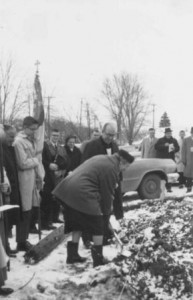
The women of the parish also gave their input as to their desires in a new building. They insisted that a large kitchen be planned for the new undercroft. They also had a room designated as the “Women’s Lounge.” With the leadership of Betty Schomaker and Betty Taylor, this room became the Library during the 1970s.
On Sunday, December 22, 1962 at the 11:00 AM Service, ground was broken for the new church. The church was dedicated by Bishop Austin Pardue a year later - December 23, 1963 at 4:00 PM. The congregation consisted of members, their friends, members of the old church, local clergy and Diocesan clergy. It was a crowd that overflowed into the Narthex.
And so it was that a group of people built not one, but two churches and a rectory in 10 year’s time! Their dedication and sacrifices should not be forgotten as we look around us today.




